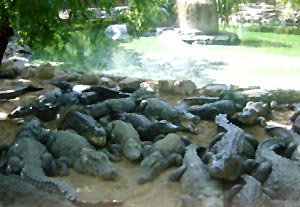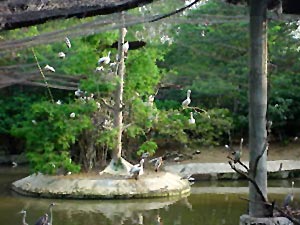There is no dearth of natural beauty in Tamil Nadu. As a result this South Indian state is perfect for nature tourism. There are ample wildlife sanctuaries, parks and gardens.
Accessed via the hill stations, the forest areas lining the state border harbour Tamil Nadu`s principal wildlife sanctuaries, Annamalai (Indira Gandhi Wildlife Sanctuary) and Mudumalai which form the vast Nilgiri Biosphere Reserve. The latter is India`s most extensive tract of protected forest. The main route between Mysore and the cities of the Tamil plains wriggles through the Nilgiri Hills and the ardent nature worshippers may well find themselves pausing for a night or two along the way to enjoy the cold air and serene landscape of the tea terraces. On the way to these wildlife parks, a stopover at the dull textile city of Coimbatore is hard to avoid, even if only to change buses.
 The Crocodile Bank is located at a distance of 42 kilometers from Chennai. It was built with the intention of protecting the endangered species of crocodiles and Alligators. Low walled enclosures in its garden compound house hundreds of inscrutable crocodiles, soaking in ponds or sunning themselves on the banks.
The Crocodile Bank is located at a distance of 42 kilometers from Chennai. It was built with the intention of protecting the endangered species of crocodiles and Alligators. Low walled enclosures in its garden compound house hundreds of inscrutable crocodiles, soaking in ponds or sunning themselves on the banks.
Another important field of work is conducted with the collaboration of local Irula people, whose traditional expertise is with snakes. Cobras are brought to the bank for venom collection, to be used in the treatment of snakebites. here at the bank only a limited amount is taken from each snake, enabling them to return to the wild.
One of India`s most spectacular bird sanctuaries lies roughly to the east of the village of Vedanthangal, a cluster of squat, brown houses set in a patchwork of paddy fields 30 km from the east coast and 86 km southwest of Chennai. It is a tiny, relaxed place bisected by one road and with just two tea stalls. A low-lying area less than half a kilometer square, the sanctuary is busiest with birds between December and February when it is totally flooded. The rains of the northeast monsoon, sweeping through in October or November, bring indigenous water birds that nest and settle here until the dry season (usually April).
 Abundant trees on mounds above water level provide perfect nesting spots, alive by January with fledglings. Visitors can watch the avian action from a path at the waters edge or from a watchtower with the help of strong binoculars. Common Indian species to look out for are open bill storks, spoonbills, pelicans, black cormorants, and herons of various kinds. You may also see ibises, grey pelicans, migrant cuckoos, sandpipers, egrets and tiny darting bee-eaters. Some migrant birds pass through and rest on their way between more permanent sites; swallows, terns and redshanks are common, while peregrine falcons, pigeons and doves are occasionally spotted.
Abundant trees on mounds above water level provide perfect nesting spots, alive by January with fledglings. Visitors can watch the avian action from a path at the waters edge or from a watchtower with the help of strong binoculars. Common Indian species to look out for are open bill storks, spoonbills, pelicans, black cormorants, and herons of various kinds. You may also see ibises, grey pelicans, migrant cuckoos, sandpipers, egrets and tiny darting bee-eaters. Some migrant birds pass through and rest on their way between more permanent sites; swallows, terns and redshanks are common, while peregrine falcons, pigeons and doves are occasionally spotted.
Other than these the tourists can also check out Point Calimere Wildlife Sanctuary, Kunthakulam Bird Sanctuary, Mudumalai Wildlife Sanctuary, Mukkurthi National Park, Kalakkadu Wildlife Sanctuary and Guindy National Park. Most of these wildlife parks are located within the vicinity of the Nilgiri Hills.



















